BUS5POE - Problem Set 10: Economic Concepts and Real-World Analysis
VerifiedAdded on 2020/03/16
|7
|1167
|134
Homework Assignment
AI Summary
This assignment solution addresses BUS5POE Problem Set 10, focusing on key economic concepts and real-world applications. Part A analyzes labor market statistics, including unemployment rates, labor force participation, and the impact of higher wages. It examines the relationship between wages, worker loyalty, and the impact of falling participation rates. Part B delves into minimum wage policies and their effects on labor markets using graphical representations to illustrate equilibrium and disequilibrium scenarios, exploring the consequences of minimum wages and union wages. The assignment further applies these concepts using real-world data from the Australian Bureau of Statistics, calculating and interpreting labor force participation and unemployment rates, and discussing potential long-term measures to reduce unemployment. The solution includes a bibliography of sources used.
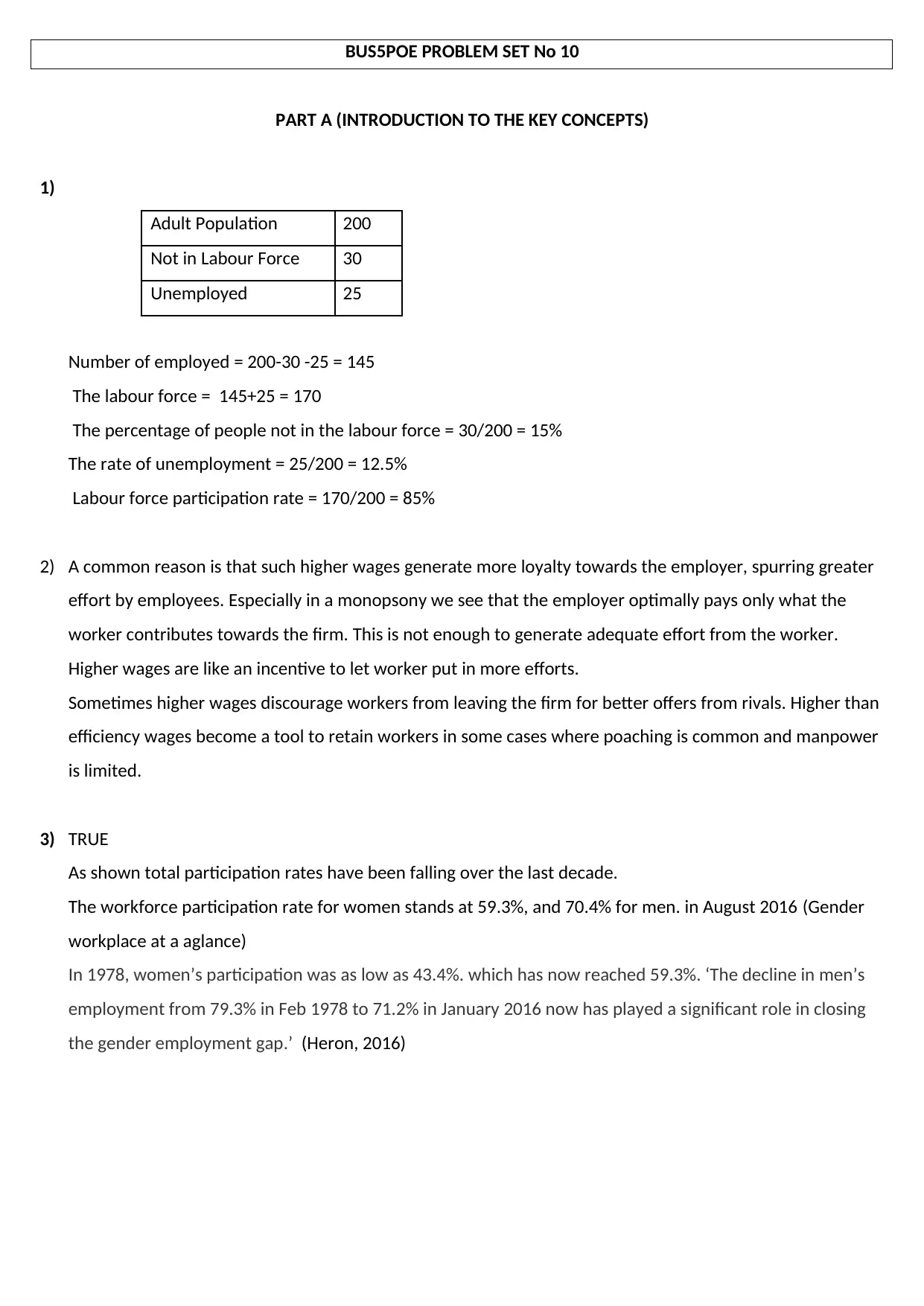
BUS5POE PROBLEM SET No 10
PART A (INTRODUCTION TO THE KEY CONCEPTS)
1)
Adult Population 200
Not in Labour Force 30
Unemployed 25
Number of employed = 200-30 -25 = 145
The labour force = 145+25 = 170
The percentage of people not in the labour force = 30/200 = 15%
The rate of unemployment = 25/200 = 12.5%
Labour force participation rate = 170/200 = 85%
2) A common reason is that such higher wages generate more loyalty towards the employer, spurring greater
effort by employees. Especially in a monopsony we see that the employer optimally pays only what the
worker contributes towards the firm. This is not enough to generate adequate effort from the worker.
Higher wages are like an incentive to let worker put in more efforts.
Sometimes higher wages discourage workers from leaving the firm for better offers from rivals. Higher than
efficiency wages become a tool to retain workers in some cases where poaching is common and manpower
is limited.
3) TRUE
As shown total participation rates have been falling over the last decade.
The workforce participation rate for women stands at 59.3%, and 70.4% for men. in August 2016 (Gender
workplace at a aglance)
In 1978, women’s participation was as low as 43.4%. which has now reached 59.3%. ‘The decline in men’s
employment from 79.3% in Feb 1978 to 71.2% in January 2016 now has played a significant role in closing
the gender employment gap.’ (Heron, 2016)
PART A (INTRODUCTION TO THE KEY CONCEPTS)
1)
Adult Population 200
Not in Labour Force 30
Unemployed 25
Number of employed = 200-30 -25 = 145
The labour force = 145+25 = 170
The percentage of people not in the labour force = 30/200 = 15%
The rate of unemployment = 25/200 = 12.5%
Labour force participation rate = 170/200 = 85%
2) A common reason is that such higher wages generate more loyalty towards the employer, spurring greater
effort by employees. Especially in a monopsony we see that the employer optimally pays only what the
worker contributes towards the firm. This is not enough to generate adequate effort from the worker.
Higher wages are like an incentive to let worker put in more efforts.
Sometimes higher wages discourage workers from leaving the firm for better offers from rivals. Higher than
efficiency wages become a tool to retain workers in some cases where poaching is common and manpower
is limited.
3) TRUE
As shown total participation rates have been falling over the last decade.
The workforce participation rate for women stands at 59.3%, and 70.4% for men. in August 2016 (Gender
workplace at a aglance)
In 1978, women’s participation was as low as 43.4%. which has now reached 59.3%. ‘The decline in men’s
employment from 79.3% in Feb 1978 to 71.2% in January 2016 now has played a significant role in closing
the gender employment gap.’ (Heron, 2016)
Paraphrase This Document
Need a fresh take? Get an instant paraphrase of this document with our AI Paraphraser
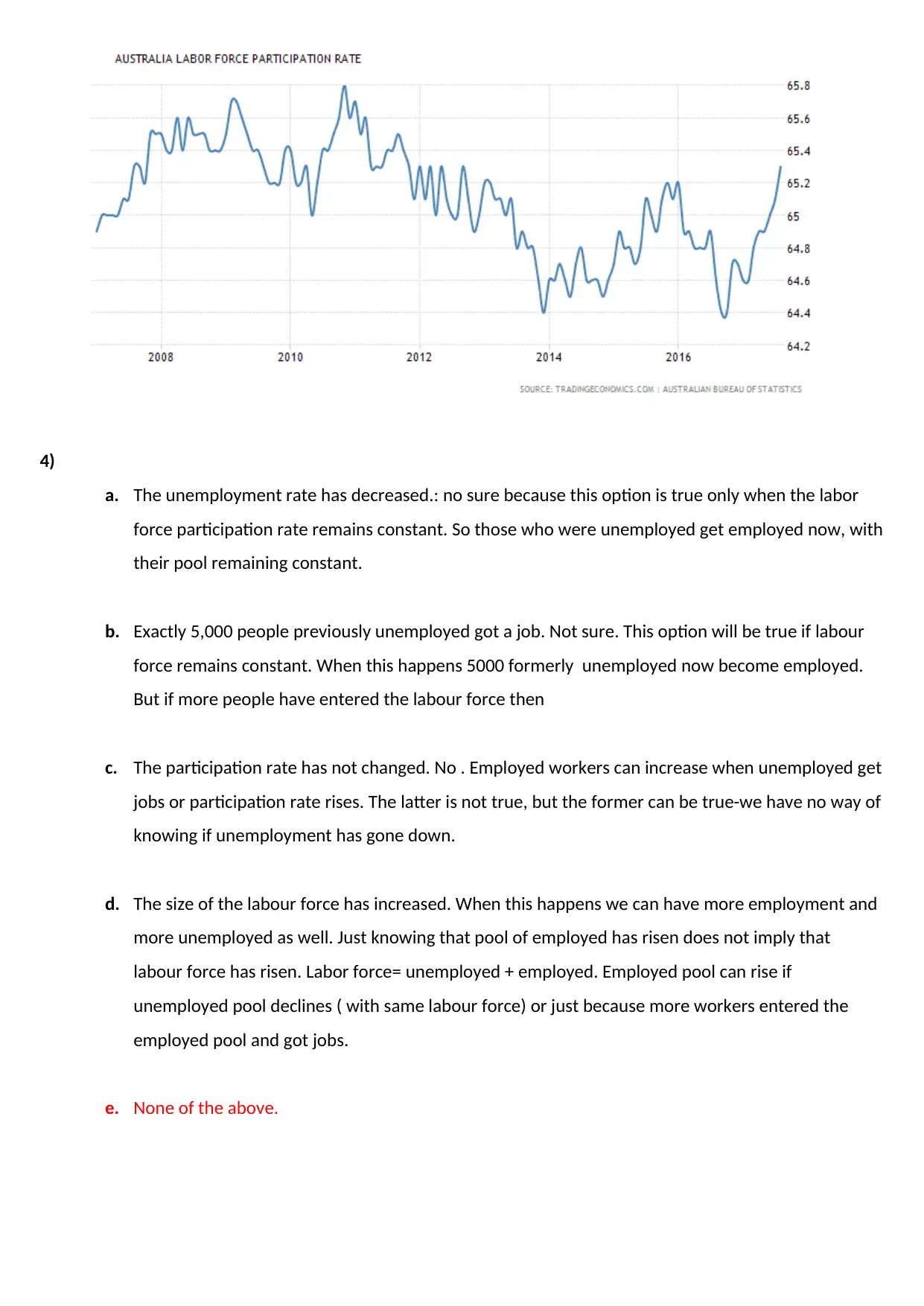
4)
a. The unemployment rate has decreased.: no sure because this option is true only when the labor
force participation rate remains constant. So those who were unemployed get employed now, with
their pool remaining constant.
b. Exactly 5,000 people previously unemployed got a job. Not sure. This option will be true if labour
force remains constant. When this happens 5000 formerly unemployed now become employed.
But if more people have entered the labour force then
c. The participation rate has not changed. No . Employed workers can increase when unemployed get
jobs or participation rate rises. The latter is not true, but the former can be true-we have no way of
knowing if unemployment has gone down.
d. The size of the labour force has increased. When this happens we can have more employment and
more unemployed as well. Just knowing that pool of employed has risen does not imply that
labour force has risen. Labor force= unemployed + employed. Employed pool can rise if
unemployed pool declines ( with same labour force) or just because more workers entered the
employed pool and got jobs.
e. None of the above.
a. The unemployment rate has decreased.: no sure because this option is true only when the labor
force participation rate remains constant. So those who were unemployed get employed now, with
their pool remaining constant.
b. Exactly 5,000 people previously unemployed got a job. Not sure. This option will be true if labour
force remains constant. When this happens 5000 formerly unemployed now become employed.
But if more people have entered the labour force then
c. The participation rate has not changed. No . Employed workers can increase when unemployed get
jobs or participation rate rises. The latter is not true, but the former can be true-we have no way of
knowing if unemployment has gone down.
d. The size of the labour force has increased. When this happens we can have more employment and
more unemployed as well. Just knowing that pool of employed has risen does not imply that
labour force has risen. Labor force= unemployed + employed. Employed pool can rise if
unemployed pool declines ( with same labour force) or just because more workers entered the
employed pool and got jobs.
e. None of the above.
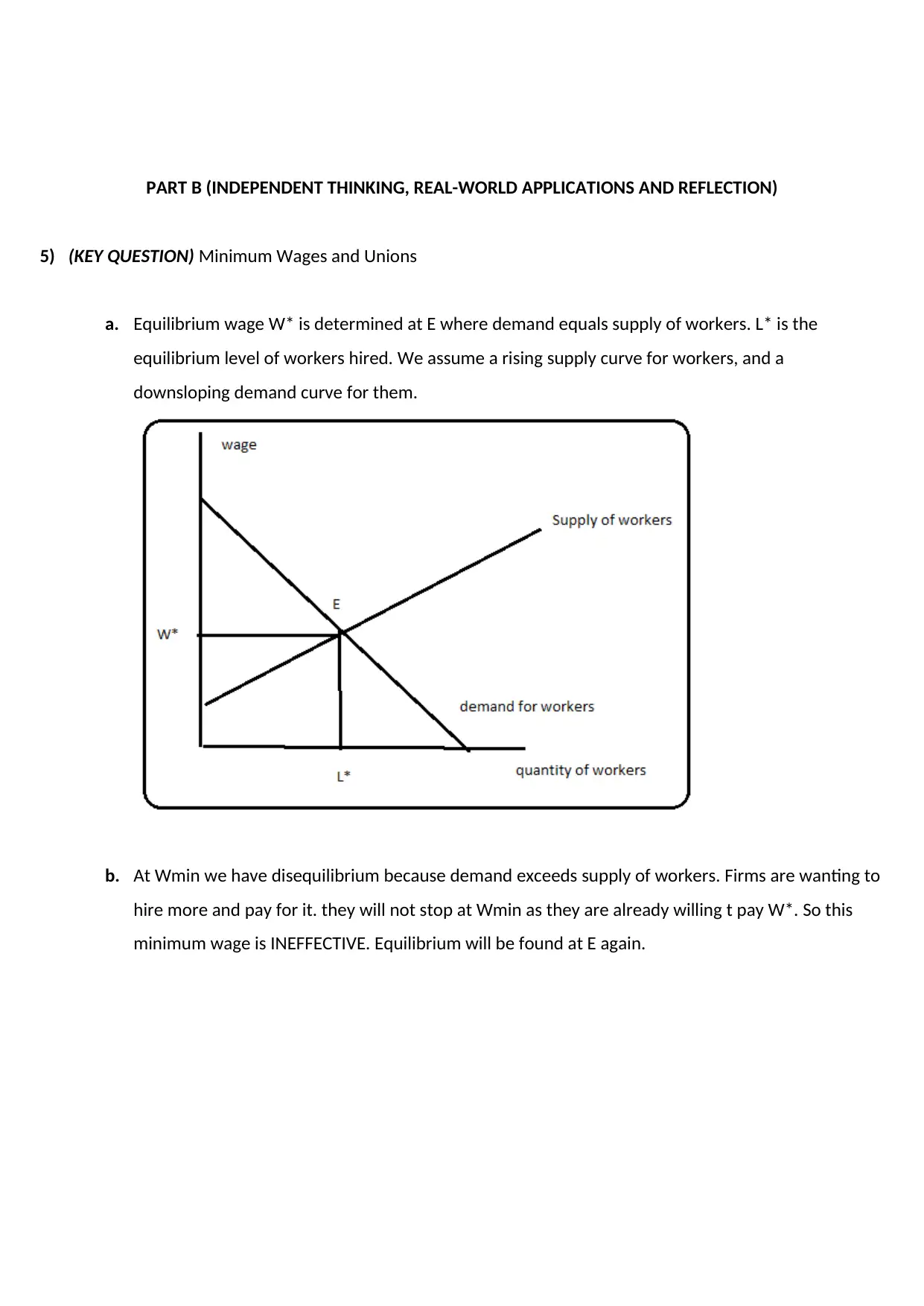
PART B (INDEPENDENT THINKING, REAL-WORLD APPLICATIONS AND REFLECTION)
5) (KEY QUESTION) Minimum Wages and Unions
a. Equilibrium wage W* is determined at E where demand equals supply of workers. L* is the
equilibrium level of workers hired. We assume a rising supply curve for workers, and a
downsloping demand curve for them.
b. At Wmin we have disequilibrium because demand exceeds supply of workers. Firms are wanting to
hire more and pay for it. they will not stop at Wmin as they are already willing t pay W*. So this
minimum wage is INEFFECTIVE. Equilibrium will be found at E again.
5) (KEY QUESTION) Minimum Wages and Unions
a. Equilibrium wage W* is determined at E where demand equals supply of workers. L* is the
equilibrium level of workers hired. We assume a rising supply curve for workers, and a
downsloping demand curve for them.
b. At Wmin we have disequilibrium because demand exceeds supply of workers. Firms are wanting to
hire more and pay for it. they will not stop at Wmin as they are already willing t pay W*. So this
minimum wage is INEFFECTIVE. Equilibrium will be found at E again.
⊘ This is a preview!⊘
Do you want full access?
Subscribe today to unlock all pages.

Trusted by 1+ million students worldwide
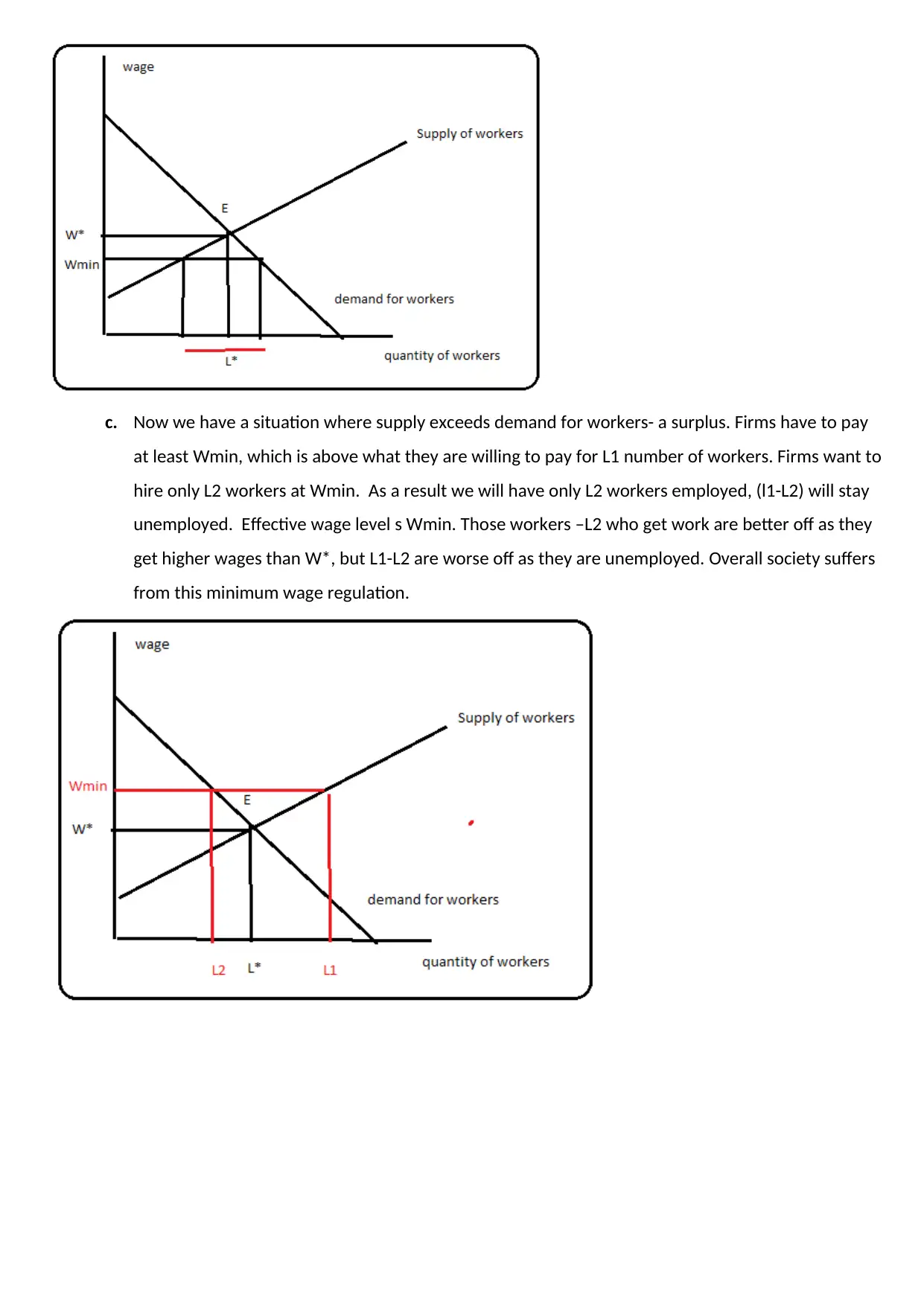
c. Now we have a situation where supply exceeds demand for workers- a surplus. Firms have to pay
at least Wmin, which is above what they are willing to pay for L1 number of workers. Firms want to
hire only L2 workers at Wmin. As a result we will have only L2 workers employed, (l1-L2) will stay
unemployed. Effective wage level s Wmin. Those workers –L2 who get work are better off as they
get higher wages than W*, but L1-L2 are worse off as they are unemployed. Overall society suffers
from this minimum wage regulation.
at least Wmin, which is above what they are willing to pay for L1 number of workers. Firms want to
hire only L2 workers at Wmin. As a result we will have only L2 workers employed, (l1-L2) will stay
unemployed. Effective wage level s Wmin. Those workers –L2 who get work are better off as they
get higher wages than W*, but L1-L2 are worse off as they are unemployed. Overall society suffers
from this minimum wage regulation.
Paraphrase This Document
Need a fresh take? Get an instant paraphrase of this document with our AI Paraphraser
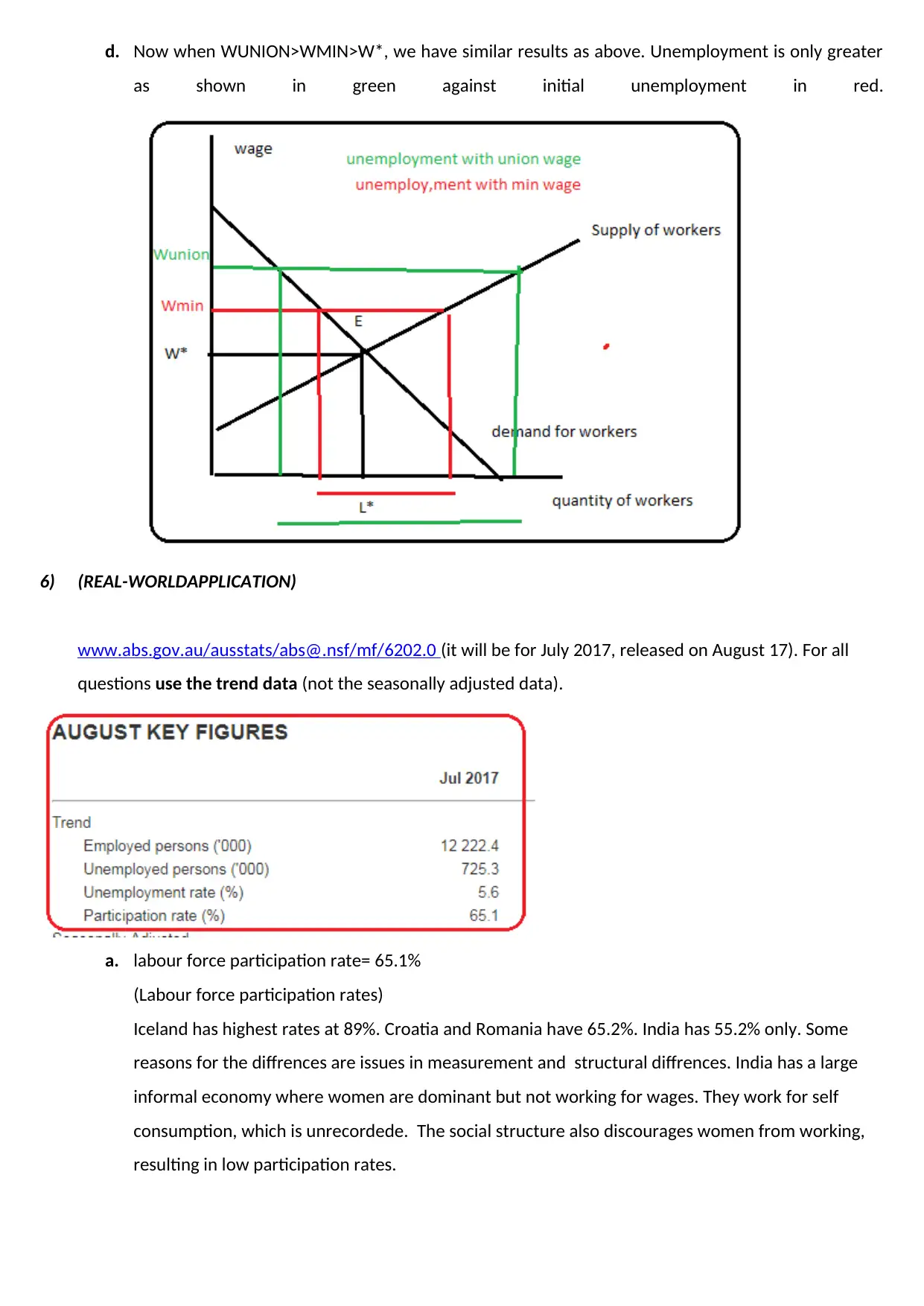
d. Now when WUNION>WMIN>W*, we have similar results as above. Unemployment is only greater
as shown in green against initial unemployment in red.
6) (REAL-WORLDAPPLICATION)
www.abs.gov.au/ausstats/abs@.nsf/mf/6202.0 (it will be for July 2017, released on August 17). For all
questions use the trend data (not the seasonally adjusted data).
a. labour force participation rate= 65.1%
(Labour force participation rates)
Iceland has highest rates at 89%. Croatia and Romania have 65.2%. India has 55.2% only. Some
reasons for the diffrences are issues in measurement and structural diffrences. India has a large
informal economy where women are dominant but not working for wages. They work for self
consumption, which is unrecordede. The social structure also discourages women from working,
resulting in low participation rates.
as shown in green against initial unemployment in red.
6) (REAL-WORLDAPPLICATION)
www.abs.gov.au/ausstats/abs@.nsf/mf/6202.0 (it will be for July 2017, released on August 17). For all
questions use the trend data (not the seasonally adjusted data).
a. labour force participation rate= 65.1%
(Labour force participation rates)
Iceland has highest rates at 89%. Croatia and Romania have 65.2%. India has 55.2% only. Some
reasons for the diffrences are issues in measurement and structural diffrences. India has a large
informal economy where women are dominant but not working for wages. They work for self
consumption, which is unrecordede. The social structure also discourages women from working,
resulting in low participation rates.
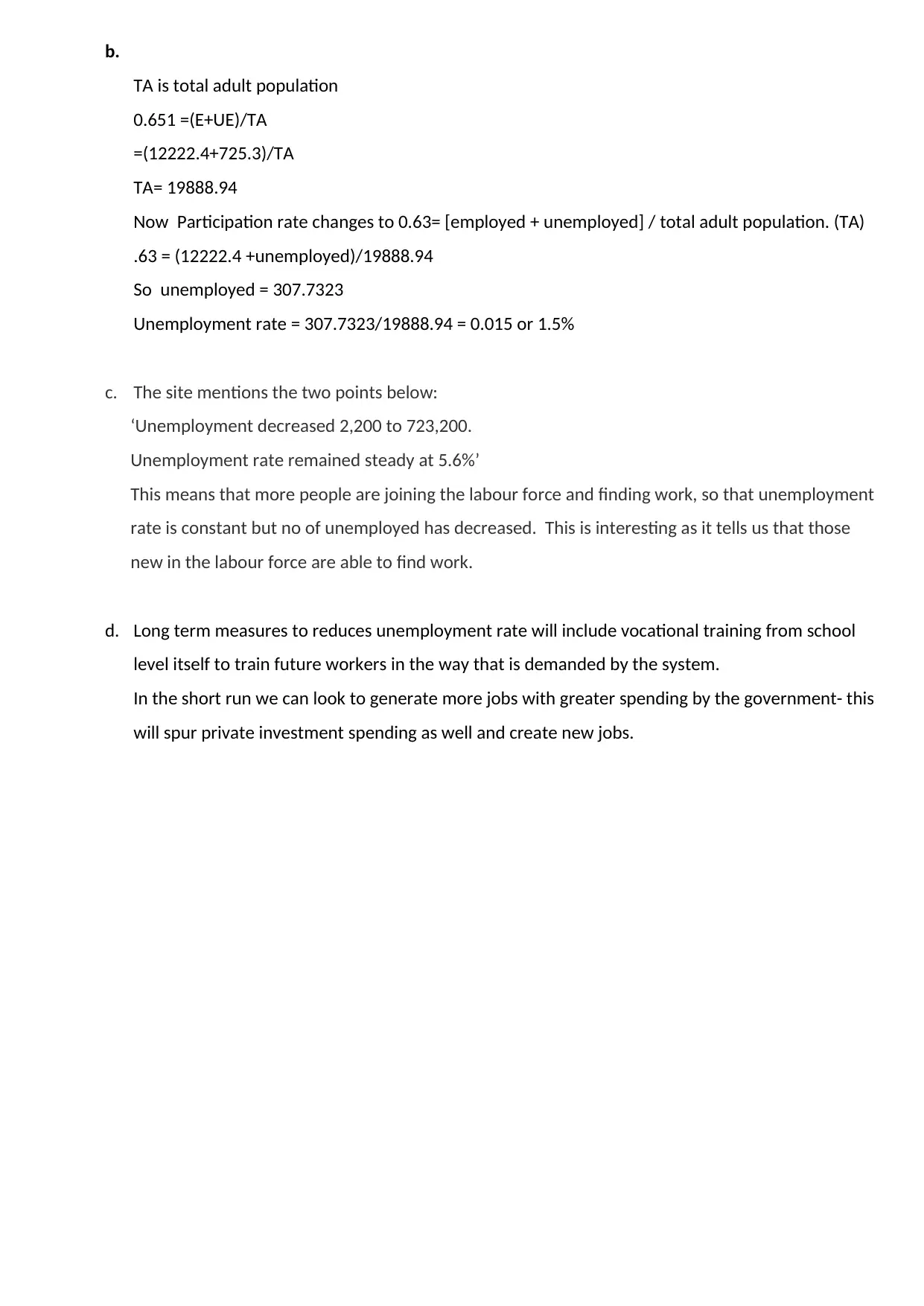
b.
TA is total adult population
0.651 =(E+UE)/TA
=(12222.4+725.3)/TA
TA= 19888.94
Now Participation rate changes to 0.63= [employed + unemployed] / total adult population. (TA)
.63 = (12222.4 +unemployed)/19888.94
So unemployed = 307.7323
Unemployment rate = 307.7323/19888.94 = 0.015 or 1.5%
c. The site mentions the two points below:
‘Unemployment decreased 2,200 to 723,200.
Unemployment rate remained steady at 5.6%’
This means that more people are joining the labour force and finding work, so that unemployment
rate is constant but no of unemployed has decreased. This is interesting as it tells us that those
new in the labour force are able to find work.
d. Long term measures to reduces unemployment rate will include vocational training from school
level itself to train future workers in the way that is demanded by the system.
In the short run we can look to generate more jobs with greater spending by the government- this
will spur private investment spending as well and create new jobs.
TA is total adult population
0.651 =(E+UE)/TA
=(12222.4+725.3)/TA
TA= 19888.94
Now Participation rate changes to 0.63= [employed + unemployed] / total adult population. (TA)
.63 = (12222.4 +unemployed)/19888.94
So unemployed = 307.7323
Unemployment rate = 307.7323/19888.94 = 0.015 or 1.5%
c. The site mentions the two points below:
‘Unemployment decreased 2,200 to 723,200.
Unemployment rate remained steady at 5.6%’
This means that more people are joining the labour force and finding work, so that unemployment
rate is constant but no of unemployed has decreased. This is interesting as it tells us that those
new in the labour force are able to find work.
d. Long term measures to reduces unemployment rate will include vocational training from school
level itself to train future workers in the way that is demanded by the system.
In the short run we can look to generate more jobs with greater spending by the government- this
will spur private investment spending as well and create new jobs.
⊘ This is a preview!⊘
Do you want full access?
Subscribe today to unlock all pages.

Trusted by 1+ million students worldwide

BIBLIOGRAPHY
Gender workplace at a aglance. (n.d.). Retrieved Oct 9, 2017, from Wgea.gov.au:
https://www.wgea.gov.au/sites/default/files/Stats_at_a_Glance.pdf
Heron, A. (2016, March 16). More women than ever are in the workforce but progress has been glacial.
Retrieved Oct 8, 2017, from Theconversation.com: https://theconversation.com/more-women-than-
ever-are-in-the-workforce-but-progress-has-been-glacial-54893
Labour force participation rates. (n.d.). Retrieved Oct 6, 2017, from Data.oecd.org:
https://data.oecd.org/emp/labour-force-participation-rate.htm
Gender workplace at a aglance. (n.d.). Retrieved Oct 9, 2017, from Wgea.gov.au:
https://www.wgea.gov.au/sites/default/files/Stats_at_a_Glance.pdf
Heron, A. (2016, March 16). More women than ever are in the workforce but progress has been glacial.
Retrieved Oct 8, 2017, from Theconversation.com: https://theconversation.com/more-women-than-
ever-are-in-the-workforce-but-progress-has-been-glacial-54893
Labour force participation rates. (n.d.). Retrieved Oct 6, 2017, from Data.oecd.org:
https://data.oecd.org/emp/labour-force-participation-rate.htm
1 out of 7
Your All-in-One AI-Powered Toolkit for Academic Success.
+13062052269
info@desklib.com
Available 24*7 on WhatsApp / Email
![[object Object]](/_next/static/media/star-bottom.7253800d.svg)
Unlock your academic potential
Copyright © 2020–2025 A2Z Services. All Rights Reserved. Developed and managed by ZUCOL.
